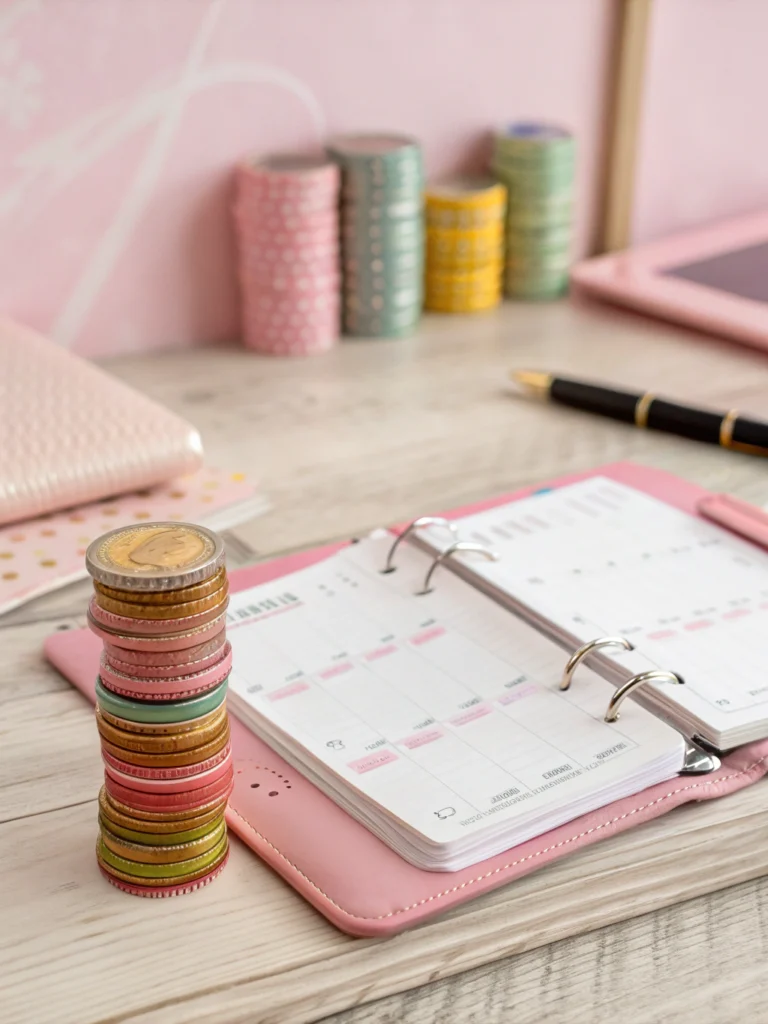Ever feel like saving money means saying goodbye to fun, flavor, and everything that makes life worth living? Yeah, I’ve been there too. Staring at my bank account, wondering if I need to cancel Netflix, sell my car, and start eating ramen three meals a day just to make it through the month.
But here’s the truth bomb: Learning how to be frugal doesn’t mean transforming into a joyless penny-pincher who hoards napkins from fast-food restaurants. It’s about making smarter choices that let you keep your cash AND your sanity. You can absolutely save money without feeling like you’re missing out on life.
No time to read the whole post?
Here’s the quick version: Being frugal isn’t about deprivation—it’s about intentional spending. Focus on what truly matters to you, cut expenses that don’t add value, embrace free entertainment, cook strategically, shop smarter (not harder), and create fun challenges around saving. You’ll discover that frugality can actually be liberating and enjoyable when you approach it with the right mindset.
What Does Being Frugal Actually Mean?
First, clear up this massive misconception: frugal ≠ cheap. Cheap people sacrifice quality and happiness to save a buck. Frugal people maximize value—they spend wisely on things that matter and cut ruthlessly on stuff that doesn’t.
Think of it this way. A cheap person buys the lowest-quality shoes that fall apart in three months. A frugal person invests in good shoes that last years, saving money long-term while keeping their feet happy. See the difference?
Being frugal means you’re intentional with your money. You’re not depriving yourself—you’re prioritizing. And honestly? That’s where the magic happens. When you stop wasting money on random stuff you don’t care about, you suddenly have more to spend on what you actually love.
Shift Your Mindset First
Before you touch your budget spreadsheet (yes, you might need one eventually), you need to rewire how you think about money and happiness.
Our consumer culture screams that more stuff = more happiness. Spoiler alert: it doesn’t. That dopamine hit from buying something new? It fades faster than your phone battery on 1%. Real satisfaction comes from experiences, relationships, and achieving goals—not from impulse purchases at Target.
Start identifying your “why.” Why do you want to save money? Paying off debt? Building an emergency fund? Traveling somewhere amazing? Retiring early so you can finally write that novel or build birdhouses full-time? Whatever it is, write it down. Put it somewhere you’ll see it daily.
When you’re tempted to buy something you don’t need, check in with your “why.” Does this purchase get you closer to your goal or further away? That mental checkpoint has saved me from countless unnecessary purchases. 🙂
Track Where Your Money Actually Goes
You can’t fix what you don’t measure. Seriously, most people have zero clue where their money disappears to each month.
Grab your bank statements from the last three months and categorize every expense. Food, housing, transportation, entertainment, subscriptions, that weird charge you don’t remember—everything. Use an app like Mint, YNAB (You Need A Budget), or even just a simple spreadsheet.
Prepare for some uncomfortable realizations. You might discover you’re spending $200 monthly on takeout coffee or $80 on subscription services you forgot existed. No judgment—we’ve all been there. But awareness is the first step toward change.
Once you see the patterns, you can make informed decisions. Maybe you genuinely love your daily latte and it brings you joy. Cool, keep it. But maybe you realize you’re paying for three streaming services and only watch one. That’s an easy cut that won’t hurt at all.
Focus on the Big Three: Housing, Transportation, and Food
Want maximum impact with minimum effort? Target your biggest expenses first. For most people, that’s housing, transportation, and food—usually consuming 50-70% of your budget.
Housing: Can you negotiate lower rent? Get a roommate? Refinance your mortgage? Move to a lower cost-of-living area? Yeah, these aren’t quick fixes, but even a 10% reduction in housing costs creates massive breathing room in your budget.
Transportation: Do you really need that car payment? Could you buy used instead of new? Bike or take public transit sometimes? Carpool? Americans spend an average of $9,000+ annually on transportation. Even small changes here add up fast.
Food: This is where most people have the most flexibility. You don’t need to eat rice and beans every night (unless you love them). Strategic grocery shopping, meal planning, and cooking at home a few extra nights per week can easily save you hundreds monthly without feeling deprived.
Master the Art of Strategic Spending
Here’s where frugal living tips get fun. Strategic spending means you deliberately choose where every dollar goes based on what adds real value to your life.
Use the “cost per use” calculation for purchases. That $200 jacket seems expensive until you realize you’ll wear it 100+ times over five years. That’s $2 per wear. Meanwhile, that $30 trendy shirt you’ll wear twice? That’s $15 per wear. Suddenly the expensive jacket is the frugal choice.
Apply the 24-hour rule for non-essential purchases. See something you want? Wait 24 hours before buying. For bigger purchases, wait a week or even a month. You’ll be amazed how many “must-haves” lose their appeal once the initial excitement fades.
Create a “fun money” category in your budget. Seriously, this is crucial for avoiding feelings of deprivation. Set aside some guilt-free spending money each month for whatever brings you joy—fancy coffee, books, hobbies, nights out. When you know you have money specifically designated for fun, you won’t feel restricted.
Embrace Free and Low-Cost Entertainment
One of the biggest myths about frugality? That you’ll be stuck at home, bored out of your mind, watching paint dry for entertainment. Nope.
Your community probably offers tons of free or cheap activities you’ve been ignoring. Free concerts in the park, museum days, hiking trails, community events, library programs (libraries are seriously underrated gold mines), festivals, art walks—the list goes on.
Host game nights instead of bar nights. Everyone brings snacks, you provide the space, and you’ve got entertainment for $10 instead of $50+. Board games, card games, video games—whatever your crew enjoys.
Get creative with dates and hangouts. Picnics, hiking, free outdoor concerts, visiting farmers markets, exploring new neighborhoods—these experiences often create better memories than expensive dinners anyway.
Nature is free, by the way. Trails, beaches, parks, mountains—they’re all just sitting there waiting for you. No admission fee required.
Cook Smarter, Not Harder
Food is where many people feel deprived when trying to save money. But you don’t need to survive on sad salads and plain pasta.
Meal planning is your secret weapon. Spend 30 minutes weekly planning meals around what’s on sale, what’s in season, and what you already have. This prevents impulse purchases, reduces food waste, and keeps you from ordering takeout because “there’s nothing to eat.”
Batch cooking saves time and money. Make a huge pot of chili, soup, or casserole on Sunday. Portion it out. Boom—you’ve got lunches or dinners sorted for days. Same effort as cooking once, multiple meals as output.
Learn to love cheaper protein sources. Eggs, beans, lentils, chicken thighs (way cheaper than breasts), and canned tuna offer great nutrition without the steak price tag. Rotate these in, and reserve pricier proteins for occasional treats.
Shop seasonally and locally when possible. Strawberries in December cost a fortune. Strawberries in June? Cheap and delicious. Work with nature’s schedule, not against it.
Pack your lunch. Yes, it’s the most obvious tip ever, but there’s a reason: it works. Making lunch at home costs $2-4 versus $10-15 buying out. That’s $2,000-3,000 annually. For sandwiches.
Make Saving Money a Game
Turning frugality into a challenge makes it way more fun and way less painful.
Try a no-spend challenge for a week or month. Only spend on absolute essentials—housing, utilities, groceries. Everything else? Off limits. See how creative you can get with entertainment, meals, and problem-solving. It’s surprisingly fun and eye-opening.
Compete with yourself. Can you beat last month’s grocery bill? Reduce your electric usage? Find a cheaper alternative to something you regularly buy? Track your progress and celebrate wins.
Join online frugal living communities. Reddit has several, Facebook has groups, and there are forums dedicated to this stuff. Sharing tips, challenges, and victories with like-minded people keeps motivation high and provides accountability.
Set specific savings goals with rewards. “When I save $1,000, I’ll treat myself to that concert I want to see.” The reward gives you something to work toward, and you’ve earned it through your frugal efforts.
Quality Over Quantity Always
Fast fashion, cheap electronics, dollar store everything—these seem frugal but often cost more long-term.
Invest in quality for items you use daily. Good mattress, quality shoes, reliable kitchen tools, durable backpack—these things affect your daily life. Buying quality once beats replacing cheap versions repeatedly.
That said, don’t overpay for brand names when generic works just as well. Store-brand medications, basic groceries, cleaning supplies—often identical to name brands but way cheaper. Read ingredients and specs, not just logos.
Buy used when it makes sense. Thrift stores, Facebook Marketplace, Craigslist, estate sales—goldmines for furniture, clothes, tools, books, sports equipment, and more. Someone else’s impulse purchase becomes your 70%-off score.
Learn basic repair skills. YouTube can teach you to fix almost anything. Sewing a button, patching jeans, basic home repairs, simple car maintenance—these skills save hundreds or thousands over time and reduce waste.
Create Frugal Habits That Stick
Sustainability beats perfection. Don’t try to overhaul your entire life overnight—that’s how you burn out and give up.
Start with one or two changes that feel manageable. Maybe it’s packing lunch twice a week and canceling one unused subscription. Once those become habits, add another small change. Compound these over time, and you’ll transform your finances without feeling overwhelmed.
Automate your savings. Set up automatic transfers to savings the day your paycheck hits. What you don’t see, you don’t spend. This removes willpower from the equation.
Find your frugal community. Whether online or IRL, connecting with others on the same journey provides support, ideas, and accountability. Plus, you’ll realize you’re not weird for caring about this stuff.
Regularly reassess and adjust. Your life changes, your priorities shift, and your budget should flex with them. Review your spending quarterly and make tweaks as needed.
The Freedom Frugality Actually Gives You
Here’s what nobody tells you about being frugal: it’s liberating, not limiting.
When you’re not living paycheck to paycheck, you stress less. When you have savings, you have options. When you’re intentional with spending, you waste less time and energy on stuff that doesn’t matter.
Frugality creates space—financial space, mental space, physical space—for what actually brings you joy. You’re not depriving yourself of happiness; you’re removing the clutter so happiness can breathe.
The people who seem happiest aren’t the ones with the most stuff. They’re the ones who’ve figured out what matters to them and built their lives around that. Frugality is just a tool to get there faster.
So yeah, being frugal doesn’t mean becoming a boring hermit who eats cardboard and wears potato sacks. It means getting intentional, cutting the noise, and keeping your money for stuff that actually matters to you. Start small, stay consistent, and watch how quickly your financial stress decreases while your options increase. Your future self will definitely thank you. 😉






